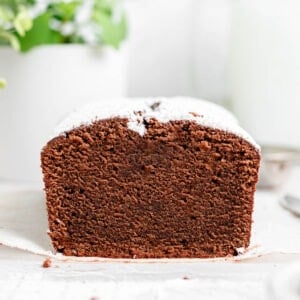Mise en Place. Bring butter and eggs to room temperature (the butter should be cool but soft to the touch, not melty or greasy). Measure both sugars into one container. In another container, whisk together flour, baking powder, and salt and set aside. Sift cocoa powder. Grease an 8×4″ loaf pan and line with a parchment paper sling. Set aside.
Preheat oven to 350°F.
Bloom cocoa powder. Scald milk in a small pot over low-medium heat on the stove, swirling the pot frequently until small bubbles form around the edges. When you tilt the pot there will be lots of active little bubbles on the bottom of the pot. You’re aiming for a temperature of 170°-180°F. Do not boil the milk. Remove from heat and add the sifted cocoa powder all at once. Whisk well until no clumps remain, then add sour cream and whisk until smooth and combined. Set aside.
Cream butter and sugar. Cut the butter into large chunks and place in the bowl of a stand mixer. Beat on medium speed to soften, about 1 minute. Scrape down the sides of the bowl and add both sugars. Beat on medium-low speed until there’s no loose sugar in the bowl, then increase speed to medium and continue creaming for 3-7 minutes, pausing to scrape down the bowl and the beater at least 3 times. Properly creamed, the butter and sugar will be pale brown and have a fluffy, airy, and paste-like texture. Scrape down the sides of the bowl.
Add eggs. One at a time, crack an egg into a small bowl (to avoid getting shells in your cake!) then dump the egg into the mixer bowl, beating on medium speed for at least 60 seconds and scraping down the bowl again before adding the next egg. Scrape down the bowl and beater again at the end.
Alternate adding dry and wet ingredients. With the mixer running on the lowest possible speed, alternate adding one third of the dry ingredients with one half of the wet ingredients, starting and ending with the dry ingredients (dry —> wet —> dry —> wet —> dry). Pause the mixer and scrape down the bowl and beater between each addition.
Stop the mixer when the batter is mostly combined and just a few streaks of flour are visible. Use a spatula to mix in any final bits of dry ingredients from the sides of the bowl or beater, making sure to scrape and stir all the way to the bottom of the bowl where sneaky bits of butter and sugar may be hiding.
Bake. Scrape the batter into the parchment lined loaf pan. Use a mini offset spatula to smooth out the batter, pressing it down into the corners and sides of the pan so that there aren’t any trapped air bubbles. Cut a ⅛-inch thin slice of a stick of butter into small sticks and arrange them in a line down the middle length of the pan to help control the crack in the top of the loaf as it bakes. Bake in the center of a 350°F oven for 70-75 minutes, until a toothpick or cake tester inserted in the center comes out with just a few crumbs clinging to it.
Cool. Remove the pan to a cooling rack. Let cool 15-20 minutes, then use the parchment sling to lift the cake out of the pan to finish cooling. Let cool completely before adding icing.
Powdered sugar. When the cake is completely cool, sift powdered sugar over top to serve.
